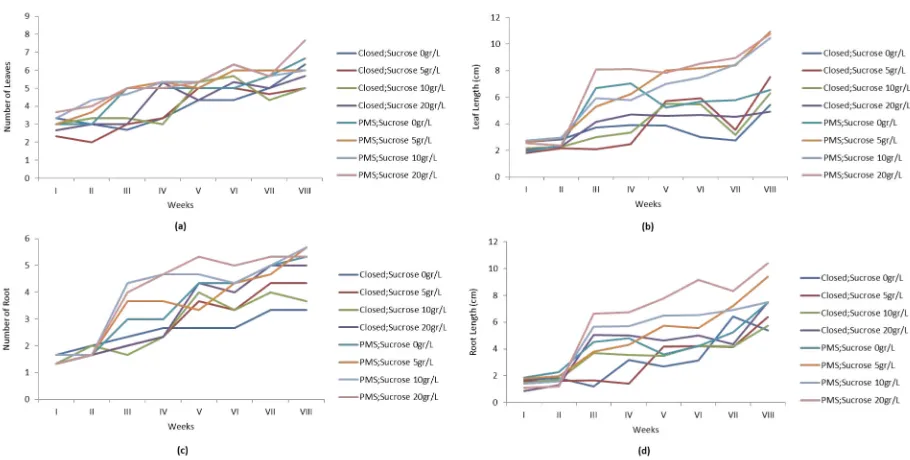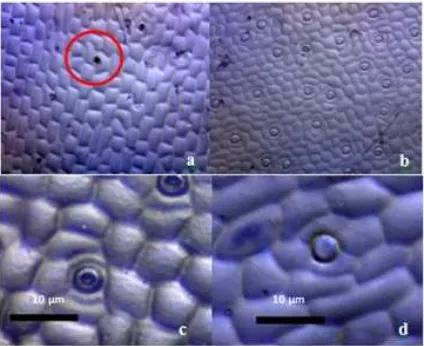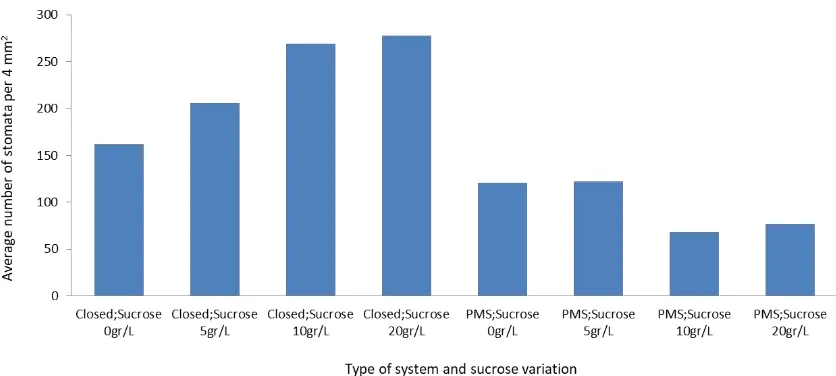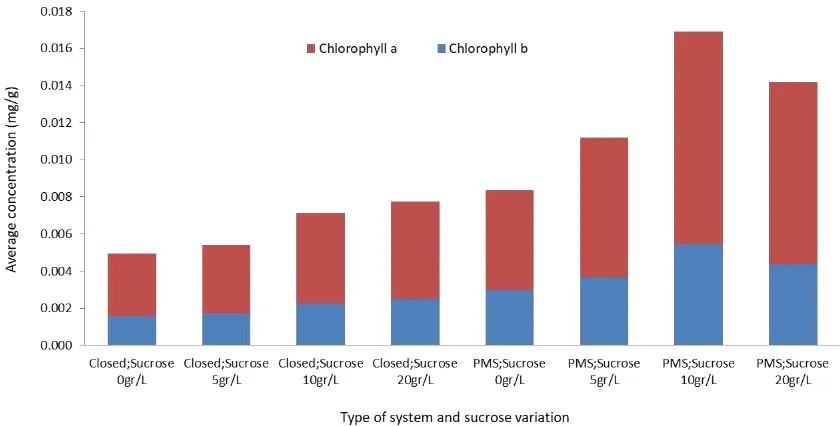Introduction
Indonesia is one of the countries in the world with the biggest source of biodiversity of orchids, which is approximately 5000 species (Irawati, 2001). Some species of orchids have been used as ornamental plants because of its high aesthetic value (Yulia and Ruseani, 2008). The tiger orchid Grammatophyllum
scriptum (Lindl.) BI. is one of the best orchids with high aesthetic value due to the number of flowers per stack (25–50 flowers); long lasting and vigor, which makes them very good to be an ornamental plant (Hani, 2015). Propagation of wild orchids like G. scriptum is needed for conservation and cultivation. Natural orchid propagation has a low success rate. According to Hani (2015), the environment has a significant role in propagating orchids naturally in their habitat. The environment comprises moisture,
temperature, and light, along with the structure of orchid seeds that impede natural germination. A microscopicsized orchid seed consists of two parts, which are embryo and testa (seed coat) (Soeryowinoto, 1987). Most of orchid seeds do not have endosperm, so it also impedes the growth and development of the orchid embryo in nature (Hani, 2015). In vitro culture is one of the main techniques to propagate orchids. With this culture, orchids can be propagated easily and quickly (Rosdiana, 2010). The orchid plantlets will face environmental stress when they are transferred to the ex vitro environment, so it has a higher risk of death. This happens because the structures of the plantlets have thin cuticle layer, imperfect vascular tissue, and reduced stomata function (Torres, 1989). In addition, plantlets in in vitro culture area used to being in heterotrophic condition with a supply of nutrients available in the culture medium, so the adjustment in the autotrophic condition in acclimatization process is going to be difficult. That is why an appropriate in vitro propagation technique is needed so the orchid plantlets will have a higher success rate when doing acclimatization.
The Growth Improvement of
Grammatophyllum scriptum
(Lindl.) Bl.
In Vitro Plantlet using Photoautotrophic Micropropagation System
Aries Bagus Sasongko
1, Asruwaidah Fatumi
1, Ari Indrianto
1,*1Laboratory of Biotechnology, Faculty of Biology, Universitas Gadjah Mada,
Jalan Teknika Selatan, Sekip Utara, Yogyakarta 55281, Indonesia
Abstract
To improve the growth ofGrammatophyllum scriptum(Lindl.) Bl. in vitro plantlet, a photoautotrophic micropropagation system (PMS) was developed by growing in vitro plantlet on VW medium with varying concentration of sucrose (0, 5, 10, and 20 g/L) and additional carbon dioxide from the air (bottle covered with cap or filter). The result showed that the leaf length would increase up to 6.5 cm with PMS and it would keep growing by the adding of 5 g/L sucrose. Average number of leaves increased by 6.7 strands with PMS and the addition of sucrose increased the average quantity of leaves up to 7.7 strands. Average number and root length would increase with PMS and would even increase more with 5 g/L sucrose addition. PMS with 5 g/L sucrose can increase chlorophyll a and b concentration. The number of stomata per unit area in PMS was lower than closed culture. This shows that PMS can increase the growth ofG. scriptumin vitro plantlet and the growth increase would be effective if it is combined with sucrose addition.
Keywords: Plant growth,Grammatophyllym scriptumplantlet, photoautotrophic micropropagation system, in vitro, carbon dioxide
*Corresponding author: Ari Indrianto
Laboratory of Biotechnology, Faculty of Biology, Universitas Gadjah Mada, Jalan Teknika Selatan, Sekip Utara, Yogyakarta 55281, Indonesia
condition will impede the growth process accelerate aging process (Hew and Yong, 2004). Photoautotrophic micropropagation system (PMS) is a micropropagation method using media without sugar, vitamin, and amino acid, and only with inorganic materials only. This system emphasizes on the CO2 contents, light intensity, and relative moisture. The advantages of this method are to reduce microbial contamination risk and increase plantlets’ growth by giving light and high amount of CO2in the bottle (Xiao and Kozai, 2006). This method can induce photosynthetic process. PMS has been proven to enhance the growth of Cymbidium, Phalaenopsis, and
Epidendrumorchids (Teixera da Silvaet al., 2005). In order to improve the growth of G. scriptum in vitro plantlet, research about the effects of PMS onG. scriptumin vitro plantlets is needed.
Materials and Methods
Plant material and growth condition G. scriptum plantlets aged 12 months and have two leaves were grown in Vacin and Went (VW) medium in accordance with Arditti (2008) with variations of sucrose (0, 5, 10, and 20 g/L) and variations of bottle caps, which were aluminium foil and rubber cap with filter based on certain modified pipe (Table 1). The culture was maintained by
weighing 0.1 g were crushed in a porcelain mortar and dissolved in 10 mL of 80% acetone, then filtered with filter paper. The solution was put into the test tube and covered with aluminum foil and then absorbance was measured using spectrophotometer with the wavelength of 645 nm and 663 nm. Chlorophyll concentration was calculated using the following Eq. 1 and 2.
Measurements of growth parameter
The leaves that were counted were those that had perfect shape and green in color. All measurements were done once a week for eight weeks.
Anatomic preparation of stomata and leaves Leaves ofG. scriptumplantlet from each treatment were taken and polypropylene based glue was smeared on the abaxial surface as the mold. After it dried, the glue was peeled and observed under a microscope with a magnification of 10x10, and then the calculation of the number of stomata with leaf area of 4 mm2was made. The transverse section of the
leaves was observed by making new incisions on the third plantlet leaf with a holder in the form of carrot slices to make the incisions easier. The result was put in the beaker glass
and observed using a light microscope with magnification of 4x10. The pictures were taken using Optilab.
Results and Discussion
This research uses two systems in vitro cultures: closed system and open system. The difference between these two systems lies in the air exchange factor between in vitro culture and ex vitro environment. The difference between these two systems has an impact on the environment of in vitro culture. The closed system has high moisture, low CO2, and ethylene gas accumulation. In contrast, the open system has relatively low moisture, there was more of CO2and there
was no accumulation of ethylene.
PMS applies the open in vitro culture system with modification of sucroseless medium. Plantlets grown using this system will have a better growth rate than that using the closed system. In addition, the survival rate of in vitro plantlet will increase because of its ability to adapt to the ex vitro environment.
This research focuses on the growth of
G. scriptum plantlets through in vitro cultivation in closed and open systems both by PMS medium without sucrose and with sucrose. Growth characters observed were the leaf organs and roots, along with chlorophyll content.
Figure 1. Morphology ofG. scriptumplantlets in the open and closed system with various sucrose concentration. Photoautotrophic micropropagation system, which is an open system with a sucroseless medium. Sign (+) indicates open system/CO2addition from the air, and sign () indicates closed system/no air exchange. The arrow sign indicates the height of plantlets in in vitro culture. Scale bar = 5cm.
same effect was also seen after adding 10 g/L sucrose in the closed system.
CO2addition in the system affected the leaf growth, especially when compared with closed culture with sucrose concentration of 20 g/L. However, plantlet leaves grown in PMS with an addition of 5 g/L sucrose were longer when compared with all treatments. In addition to the leaf length, the leaf number in the plantlets grown on PMS was also increased. It also happened to the leaves on the plantlets grown in the closed system with an addition of 20 g/L sucrose (Figure 2a and 2b). This also shows that the function of photosynthesis would be more optimum if the size and quantity of leaves increased.
The number of roots in the plantlets grown in PMS increased. Sucrose addition on PMS (starts from 5–10 g/L) would increase the average of plantlet roots quantity up to 5.7 times. Root growth was also shown by the root elongation. Plantlets grown in PMS with the addition of 5–20 g/L sucrose have a better average of root length compared to the closed system (Figure 2c and 2d). This shows that the function of nutrient absorption by the root will be more effective using PMS.
Leaf anatomy
In addition to the length and number of leaves, leaf thickness and stomata density was also observed. The results showed that the leaves of plantlets in the treatment of a closed system, in general, were thicker compared to PMS. The addition of sugar to PMS had a tendency to increase leaf thickness for more than 50% compared to PMS. Leaves appeared to become increasingly thicker within a closed system with the addition of 20 g/L of sucrose (Table 2). It suggests that
closed system can lead the plantlet leaf thickness increased due to the high water content in the culture system. This causes the cells to undergo expansion. However, the factors that led to leaf cell division has not been observed in this study.
In ex vitro,G. scriptum, stomata could be found on both sides of the leaf, which is both the adaxial and abaxial side. It is evident in Figure 3 that the quantity of stomata on the adaxial section of the leaf is much larger and denser compared to its abaxial section. Stomata open around 7:00 AM in the morning and close at night. It indicates that CO2 absorption occurs from morning to evening. However, the precise time on which stomata closes onG. scriptumhas not been investigated in this study.
The number of stomata in plantlet leaves per 4 mm2 increased in a closed system. The stomata would then decline in PMS. In a closed system with high levels of sucrose
(20 g/L), the number of stomata had increased to almost 30%, or 115 stomata per 4 mm2. The
addition of CO2and 10 g/L sucrose lowered the number of stomata to 94.33 stomata per 4 mm2, or as much as 40% less compared with
the closed systems without the addition of sucrose (Figure 4). This may indicate that the presence of CO2in the PMS can reduce the number of stomata. It is suspected that there is a connection between CO2and the number of stomata per unit area.
Chlorophyll level
The quantity of chlorophyll related to the level of photosynthetic activity. Increased chlorophyll levels mean increased photosynthesis activity, and thus can be used as an indicator of growth and effectiveness of CO2 binding. The total chlorophyll quantity, or chlorophyll a and b in PMS with additional 10 g/L sucrose, showed the highest results. Without the addition of sucrose, plantlets grown on PMS showed an increase in the quantity of total chlorophyll compared to plantlets in a closed system without the addition of sucrose, which quantified to almost 25% (Figure 5). This shows that there is a connection between chlorophyll content and addition of CO2.
Cultured in vitro orchids have shown lower acclimation success rate. This is due to differences between the environmental
conditions (ex vitro) at the time of acclimatization and conditions when the plantlets were cultured in vitro. Such differences include the level of moisture, nutrient supply, temperature, light intensity, and carbon dioxide for photosynthesis. In this culture, aseptic conditions must be maintained in order to prevent contamination by bacteria or fungi, through sterile conditions and closed systems. However, this can lead to a shortage of carbon dioxide resulting in reduced effective autotrophic function of the plantlets.
PMS is expected to supply plantlets with carbon dioxide, which in turn will accustom these plantlets to start photosynthesising optimally during in vitro because they are supported by an adequate supply of carbon dioxide. Carbon dioxide acts as a raw material in photosynthesis (high carbon dioxide levels support plant growth). In this system, the plantlets were grown on a medium without sucrose. The process aims to prioritize the CO2consumption as a carbon source for plantlet photosynthesis rather than sucrose. This will result in optimal photosynthesis during acclimatization while increasing the survival of plantlets in ex vitro conditions.
treatments. The plantlets ability to photosynthesize in in vitro conditions also decreased, thus requiring more exogenic carbon for growth, which could be obtained from sugar or sucrose (Hew and Yong, 2004). This led to the need to understand the correlation between carbon dioxide levels and sucrose quantity, both of which were nutrients needed by the plantlets. In general, 20–30 g/L of sucrose was added to every liter of the medium. With the addition of more carbon dioxide, it was hoped that the amount of nutrient given to each growth medium could be decreased to increase the plantlets autotrophic attribute. The increase in carbon dioxide levels should be proportional to the increase in the plantlets growth parameter. The study measured the growth parameters of G. scriptum orchids, which were leaf quantity, leaf length, root quantity, and root length.
A large number of leaves in the PMS treatment with the addition of 20 g/L sucrose showed that there was a large sugar sink capacity within G. scriptum plantlets. According to Campbell et al. (2004), plants have organs that function as sugar sink and sugar source. Organs that function as sugar sinks are roots, tubers, stems, fruits, and leaves in their development phases (Campbellet al. 2004). Therefore, as plantlets receive a large sugar supply, it can be then stored in the stem.
It is similar to fully developed leaves and it indicates that sugar levels can increase the number of leaves in the plantlets.
The roots are essential during acclimatization. For this reason, during acclimatisation plantlets that are chosen should have strong roots in order to adapt to ex vitro environments and can quickly absorb water and other nutrients content in the acclimatization medium. The existence of long and abundant roots can increase a plant ability to absorb nutrients. This is especially true for epiphytic plants like theG. scriptum.
Photosynthesis process in plants is not only affected by light, water, carbon dioxide levels and other factors but it is also greatly influenced by the chlorophyll within the plants themselves (Sasmitamihardja and Siregar 1997). Chlorophyll is a green plant pigment and is located in the chloroplasts. The ratio of chlorophyll a and chlorophyll b in higher plants is 3:1 (Suprapti, 2005). This study measured the levels of chlorophyll a, chlorophyll b, and the total chlorophyll amount within plantlets in each individual treatments. High chlorophyll levels indicate that the plants are actively photosynthesizing and can also be applied as a growth indicator.
This study also observed G. scriptum
types, thin and succulent (Hew and Yong, 2004). Leaf thickness is associated with photosynthetic activity. Thinleaved orchids generally have type C3 photosynthesis, while the thickleaved variant have CAM (Crassulacean Acid Metabolism). Apart from the thickness of the leaves, photosynthesis types can also be seen from the time of stomatal opening. C3type plants’ stomata will open at noon, while CAM plants’ opens at night. This is a form of environmental adaptation to temperature and water availability (Zots and Tyree, 1996). CAM plants are usually plants that can adapt in dry places. Crop yielded from in vitro culture generally have thick leaves. Differences in the thickness of the leaves can be affected by the division of parenchyma cells in the mesophyll. It can also be caused by parenchyma cells increasing in size on mesophyll due to high moisture condition. Moisture or atmospheric water content is an important factor that affects the success rate of acclimatization. In vitro culture plantlets commonly have thick leaves because the plantlets grew on a medium with high humidity. This is due to the extreme environment switch, which resulted low acclimatisation success rate. Thinner leaves, on the other hand, are assumed to be more adaptable in environments with low humidity. PMS treatment during the in vitro culture process was known to have lower air moisture around plantlets due to the increased air circulation inside the culture bottle that flows through the gooseneck pipe opening.
Stomata were found on both the adaxial and abaxial sides of the leaf, making the leaf belong to amfistomatic. However, it is evident in Figure 3b that the number of stomata on the abaxial leaves is much larger and denser than those of abaxial leaves (Figure 3a). Figure 3c and 3d shows thatG. scriptumleaf stomata opens in the morning at around 07.00 and closes at 19.00 in the evening. This proved thatG. scriptumhas type C3 photosynthesis because the stomata open in the morning, thus carbon dioxide fixation took place in the morning.
Stomata has become an important object of observation because the majority of moisture
within a plant will exit through the structure (Zots and Tyree, 1996). Stomata is also a highly adaptive structure. Desert plants have a lower stomata density compared to the plants that grow in wetter environments. Campbellet al. (2004) stated stomata density is flexible and changes accordingly depending on the treatment given. Addition of light intensity and low carbon dioxide levels can increase stomata density (Campbellet al., 2004).
Conclusions
The use of PMS or an open system with additional CO2 from the air and sugarfree medium can increase the growth ofG. scriptum
plantlets. PMS provides better results in terms of morphology, anatomy, and physiology, increases leaf and root growth, lower stomata count, thicker leaves, and higher chlorophyll levels.
Acknowledgments
The researchers are thankful for the support from Universitas Gadjah Mada Research Directorate through the Progran Peningkatan Kapasitas Peneliti Dosen Muda dengan Sumber Dana Bantuan Pendanaan Perguruan Tinggi Negeri Badan Hukum Direktorat Penelitian(Capacity Enhancement for Young Lecturer Researchers Funded through Financial Assistance for Autonomous Public Universities from the Research Directorate) number: 1590/UN1P.IIILT/ DITLIT/2016 dated April 28, 2016.
References
Arditti, J. (2008) Micropropagation of Orchid. 2ndedition vol. 1. Oxford UK: Blackwell
Publishing.
Campbell, N.A., Reece, J.B., and Mitchell, L.G. (2004) Biologi. 5thedition vol. 1. Jakarta:
Erlangga. pp. 302–310.
Haney, R., Brinton, W., and Evans, E. 2008. Soil CO2 respiration: comparison of chemical titration, CO2IRGA analysis and the Solvita gel system. Renewable Agric. Food Syst., 23(2), 171–176. doi: 10.1017/S174217050800224X
konsentrasi zat pengatur tumbuh secara in vitro. Jurnal Agrisistem, 6(2), 88–96.
Sasmitamihardja, D dan Siregar, A. (1997) Fisiologi tumbuhan. Bandung: Jurusan Biologi FMIPA–ITB. Proyek Pendidikan Tenaga Akademik Direktorat Jenderal Pendidikan dan Kebudayaan.
Suprapti, E. (2005) Kadar klorofil dan karotenoid daun kentang (Solanum tuberosumL) yang ditanam pada jarak lokasi penanaman berbeda dari sumber sulfur kawah Sikidang Dieng. Bachelor thesis. Semarang: Universitas Diponegoro. Soeryowinoto, M. (1987) Mengenal anggrek
alam Indonesia. Jakarta: PT Penebar Swadaya.
Teixera da Silva, J.A., Giang, D.D.T, and Michia, T. 2005. In vitro acclimatization of banana andCymbidium. Int. J. Bot., 1(1), 41–49. doi:10.3923/ijb.2005.41.49. Torres, K.C. (1989) Tissue culture techniques for horticultural crops. New York: Van Nostrand Reinhold.
Xiao, Y., and Kozai, T. 2006. In vitro multiplication of statice planlets using sugarfree media. Sci. Holtic., 109, 71–77. Yulia, N.D., and Ruseani, N.S. 2008. Studi habitat dan inventarisasi Dendrobium capraJ.J. Smith di Kabupaten Madiun dan Bojonegoro. Biodiversitas, 9(3), 190–193.




